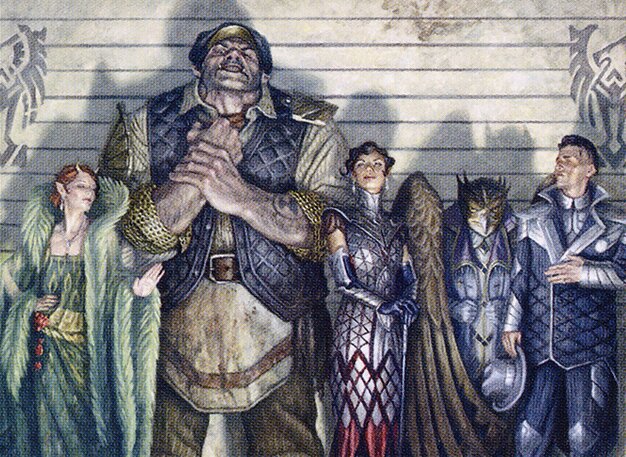I’m preparing a new campaign for my play group. In this campaign I want my players to have freedom to pursue whatever interests them. Usually, I would offer multiple paths through the campaign’s low and middle levels. The campaign’s villain would lurk in the background, influencing events in ways large and small. Once the party is ready, they would directly confront the villain.
I want to try something different this time. A major theme of my new campaign is collaborative exploration between the players and me. I wanted the campaign structure to reflect that collaborative element. I plan to spend the first five or so levels introducing the players to the campaign world and planting seeds of threats. Then I’ll present the party with several adventure hooks that make it clear what theme the rest of the campaign will take. Once the players start pursuing a particular threat, the others can either fade away or be shortened into one-session adventures. Oh, and I want to do a minimum amount of work.
In this post I’ll take what I’ve learned about campaign design from all the great TTRPG resources out there and create a top-level outline for a campaign. This is not an idle exercise; I’ll reference this outline as the campaign progresses. If my project interests you, why not message me on Mastodon? If there’s an easier way that I could go about preparing my campaign, tell me: @[email protected]
Save Work through Spiral Campaign Development
I don’t know if Mike Shea coined the term spiral campaign development, but I first heard about from him. As I understand it, spiral campaign development encourages us to think about a campaign’s macro themes in simple and general terms. These act as sort of mental landmarks to orient the group within the campaign. We add finer detail only as required by the characters’ actions.
Mike Shea has an important corollary to spiral campaign development. That is, nothing exists in the campaign world until it is shared with the players. I think this corollary serves to remind the GM not to construct elaborate “off-screen” worlds. When following spiral campaign development, the GM focuses on the characters–their actions, their abilities, their goals.
Since we haven’t made characters yet, I don’t know anything about the player characters let alone their actions. I’ll keep details minimal. At this stage in my preparation, I’m just going to make a list of possible campaign villains. This list acts as mental landmarks for the campaign.
| Villain | Location |
| An Aboleth | At the bottom of a deep trench off the coast |
| A Corrupted Dragon | Deep in the forest |
| A Rogue Modron Collective | A demiplane that primes accidently accessed |
| Vampire Oligarchs | An ancient city at the heart of a trading empire that I’ve dubbed “vampire Venice” |
| An Outer Realm Entity | A forgotten portal on the Near Moon, a small moon two miles above the surface |
| A Demilich | A sunken necropolis deep in the marshes |
I’ll likely come up with more villains as we play, but for now these are some ideas. I can downgrade any of these to side-adventures or skip them entirely.
No Quantum Ogres in these Woods
While traveling along a woodland path, the party and comes to a fork. They go right and a short time later they encounter an angry ogre. What the players don’t know–but may suspect–is that had they taken the left fork, they would have encountered the same ogre. That is the quantum ogre; it lurks on both paths simultaneously and appears on whichever path the party takes. The quantum ogre is a metaphor for when a GM prepares only one path for the players while pretending to give them choices.
If I’m not going to have quantum ogres, I must present my players with real choices. How do we distinguish a real choice from a quantum ogre? After all, if the party comes to the fork in the path, what’s to say that the GM has two different encounters prepared? The answer: we can make a choice salient by telegraphingthemes to the party.
Back to our fork in the path. Except this time one way leads downhill into thicker, darker forest where streams mingle and merge until they form a great river. The other way climbs towards a ridgeline where the tree cover breaks, and the party will likely march exposed to the sky. Now suppose corrupted treants attack the party along the first path and a pair of manticores swoop down on the party along the second path. We successfully telegraphed the encounter themes. The party didn’t choose the encounter, but they did choose the theme. More to the point, the party knows that they made a consequential choice.
So, I want to give my players real choices that they will know are real choices. How do I do it with a minimal amount of work? Looking back at my villain list, I can add themes to each villain that I can make sure to telegraph to the party. That way, my players can choose a campaign villain that fits the story they want to tell.
| Villain | Themes |
| An Aboleth | Infiltration, mind control, cults, underwater exploration |
| A Corrupted Dragon | Spreading corruption, cults, forgotten history |
| A Rogue Modron Collective | Invading hordes, strange machines, extraplanar exploration |
| Vampire Oligarchs | Political intrigue, decadence, infiltration, curses, distant travel |
| An Outer Realm Entity | Invading hordes, cults, breaking physical laws, forbidden knowledge |
| A Demilich | Undead hordes, sacrifice, forgotten history, dark magic, curses |
If I telegraph these themes to my players, I think we’ll have an engaging campaign end-to-end. The players will know what type of adventure they’re choosing. I won’t waste time preparing material the party doesn’t pursue. When presenting my players with choices, telegraphing themes should let the players know they’re making a real choice.
Next time I’m going to take another step and produce a campaign one-pager to give to my players. If you’d like to discuss how to create engaging choices at the table, please contact me on Mastodon: @[email protected]
Feature image “Rogues Gallery” by Matt Stewart, copyright 2022 Wizards of the Coast

